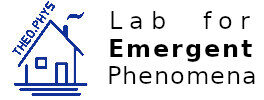Diploma thesis – Matthias Hoffmann
Matthias Hoffmann
Loop Percolation
finished 2011-07
supervised by Klaus Mecke and Gerd Schröder-Turk
Abstract
This thesis addresses physical systems where the spatial structure plays an important role in determining physical properties. In part 1, a new planar percolation model based on disconnecting nodes rather than removing edges or vertices is shown to belong to a different universality class than conventional bond or site percolation. In part 2, a numerical Minkowski tensor approach is used to study alignment and anisotropy of patterns in co-polymer films exposed to an external field. In part 1, a percolation model, termed „loop percolation“, is defined on a square grid, oriented such that the square diagonals are horizontal or vertical. Rather than removing bonds or vertices, a node is disconnected with probability p, that is, the four edges incident at a vertex are pair-wise connected. If a node is disconnected it is split into two horizontal edges (rather than two vertical edges) with probability x for nodes in lines with even line number and with probability (1-x) otherwise. As function of p the system is shown to undergo a translation transition at pc= min((2x)-1,(2-2x)-1); the parameter x tunes the affinity for disconnected sections to form closed loops. In particular, for x=1 and x=0 the model is identical to a conventional bond percolation model; for x=1/2 we find pc=1. We confirm by numerical simulation the correctness of the critical exponents of the loop percolation model that were derived (by Klaus Mecke) by a mapping to the six-vertex model and conformal field theory. The data supports the claim that for all x≠1/2 the model has the same universality as the conventional bond or site percolation model(β=5/36, ν=4/3, Df=91/48), however for x=1/2 different critical exponents β=1/3, ν=4/3, Df=79/48 are found, indicating that the model then falls into a different universality class. Part 2 demonstrates that shape indices based on so-called Minkowski tensors are a useful real-space method to study alignment and anisotropy of experimental planar gray-scale datasets. This is demonstrated by the study of scanning force microscopy images of a microphase-separated thin co-polymer film that is exposed to an external electric field for different exposure times T are analysed in terms of alignment and anisotropy of the observed pattern (the SFM images are the data described in „Electric field alignment of a block copolymer nanopattern: direct observation of the microscopic mechanism“ Soft Matter, Vol. 2, 1089–1094, 2006, courtesy of Alexander Boeker). We study eigenvalue ratios of Minkowski tensors of the segmented image data sets as a function of time, averaged over various segmentation threshold for each gray-scale image. We show that the Minkowski tensor approach yields a qualitatively similar result with respect to the anisotropy of the spatial structure and its alignment with the field direction, as did the analysis based on a Fourier method by Olszowka et al.
This thesis addresses physical systems where the spatial structure plays an important role in determining physical properties. In part 1, a new planar percolation model based on disconnecting nodes rather than removing edges or vertices is shown to belong to a different universality class than conventional bond or site percolation. In part 2, a numerical Minkowski tensor approach is used to study alignment and anisotropy of patterns in co-polymer films exposed to an external field. In part 1, a percolation model, termed „loop percolation“, is defined on a square grid, oriented such that the square diagonals are horizontal or vertical. Rather than removing bonds or vertices, a node is disconnected with probability p, that is, the four edges incident at a vertex are pair-wise connected. If a node is disconnected it is split into two horizontal edges (rather than two vertical edges) with probability x for nodes in lines with even line number and with probability (1-x) otherwise. As function of p the system is shown to undergo a translation transition at pc= min((2x)-1,(2-2x)-1); the parameter x tunes the affinity for disconnected sections to form closed loops. In particular, for x=1 and x=0 the model is identical to a conventional bond percolation model; for x=1/2 we find pc=1. We confirm by numerical simulation the correctness of the critical exponents of the loop percolation model that were derived (by Klaus Mecke) by a mapping to the six-vertex model and conformal field theory. The data supports the claim that for all x≠1/2 the model has the same universality as the conventional bond or site percolation model(β=5/36, ν=4/3, Df=91/48), however for x=1/2 different critical exponents β=1/3, ν=4/3, Df=79/48 are found, indicating that the model then falls into a different universality class. Part 2 demonstrates that shape indices based on so-called Minkowski tensors are a useful real-space method to study alignment and anisotropy of experimental planar gray-scale datasets. This is demonstrated by the study of scanning force microscopy images of a microphase-separated thin co-polymer film that is exposed to an external electric field for different exposure times T are analysed in terms of alignment and anisotropy of the observed pattern (the SFM images are the data described in „Electric field alignment of a block copolymer nanopattern: direct observation of the microscopic mechanism“ Soft Matter, Vol. 2, 1089–1094, 2006, courtesy of Alexander Boeker). We study eigenvalue ratios of Minkowski tensors of the segmented image data sets as a function of time, averaged over various segmentation threshold for each gray-scale image. We show that the Minkowski tensor approach yields a qualitatively similar result with respect to the anisotropy of the spatial structure and its alignment with the field direction, as did the analysis based on a Fourier method by Olszowka et al.
